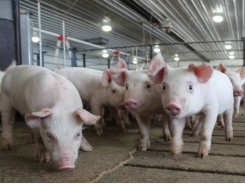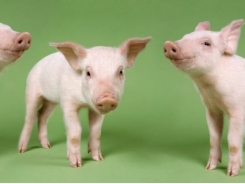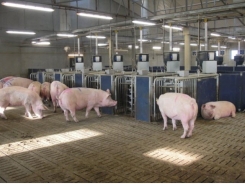What do wheat co-products have to offer swine diets?

US wheat co-products may have less variation by mill than those in other countries, and the co-product red dog may provide a greater nutritional value, says researcher.
A group of researchers from the Department of Animal Science at the University of Illinois examined the digestibility of energy and the nutrients provided in two forms of wheat co-products
The work sought to fill a knowledge gap for swine producers who wanted to make use of a commonly available, potential feed ingredient, said Hans Stein, corresponding author and professor at the University of Illinois.
“We wanted to determine what the nutritional value is and if there is variation between sources of wheat middlings [depending on where they are produced],” he told FeedNavigator.
The experiment sought to establish the composition and apparent total tract digestibility (ATTD) of gross energy (GE), dry matter (DM), organic matter (OM) and neutral detergent fiber (NDF) along with the concentrations of both digestible energy (DE) and metabolizable energy (ME) present in multiple samples of wheat middlings from across the US and in a sample of red dog, the group said in its report. Ten samples of wheat middlings were tested and one sample of red dog was because of sourcing issues.
There were some surprises in the findings, said Stein. There was an expectation that nutritional and digestibility results would vary more for the wheat middling samples than they did.
“In Canada, they have large variation among flour mills but it appears there is less variability among mills so swine producers [here] can be a little more confident that they know what they’re getting if they get these ingredients.”
Additionally, the group found that the red dog had a better nutritional profile than was expected and that it had a higher nutritional value than the wheat middlings did, he said.
1/ Why wheat co-products
In the US there has been very little work done to understand the nutritional value of wheat co-products, said Stein. However, on a global level, the grain is one of the most commonly raised.
“Most wheat in the world is grown for flour production but the 25-30% that is not used in flour production – that is used in animal feeding even in the US,” he said. “And, there is very little information but how pigs use those co-products.”
Additionally, there has been a concern about the level of variation found in wheat co-products when different batches are compared, the researchers said. Both co-products are generated during the milling process and the composition and nutritional value relate to the amount of bran, flour and germ that is included along with the nature of the original wheat and the milling process.
The feed ingredients often have been used in cattle feed and are included in swine diets, said Stein. “As corn and soybean meal have gone up in price more producers are looking to reduce price with feed ingredients,” he added.
Wheat co-products could provide a less expensive alternative ingredient, he said. Additionally, with the rise in wheat acres planted in the US this year the ingredients could be plentiful.
Although wheat middlings are a common co-product from the milling process, red dog is slightly less so in the US, he said.
2/ Methods and materials
In the digestibility trial, 12 cannulated growing pigs were given one of 12 different diets for a period of 14 days, the researchers said. Within the trial diets were rotated among pigs eight times.
A basal diet with corn and soybean meal was established as a control and 10 diets included an amount of one of the wheat middlings, they said. An additional diet was made using corn, soybean meal and red dog.
Pigs were weighed at the beginning of each trial feeding period and at the end, they said. The first seven days of each diet were considered an adaptation period and fecal markers were used on days 8 and 13.
Fecal matter was sampled twice daily and urine was collected and weighed from days 8 through 13, they said. Feed ingredients, diets, fecal and urine samples were analyzed for multiple factors.
3/ Results
The nutrient composition and the ATTD of GE for the wheat middlings were similar across the samples, said the researchers. The elements that saw the most variation were starch, NDF and total dietary fiber (TDF).
“The average concentration of CP [crude protein] was 17.67% in wheat middlings and 17.0% in red dog, and the concentration of acid hydrolyzed ether extract (AEE) and total dietary fiber (TDF) was 2.44 and 13.90% in red dog, but 4.07 and 36.45% in wheat middlings,” they said. “The average ATTD of GE, DM, OM, and NDF in wheat middlings (67.2%, 71.2%, 72.9%, and 53.0%, respectively) was less than in red dog (79.35%, 82.9%, 86.6%, and 58.7%, respectively). The average concentrations of DE and ME in wheat middlings were 2,990 and 2,893 kcal/kg DM, and these values were less than the DE and ME in red dog.”
Red dog had more starch than the wheat middling samples, but amounts of NDF and TDF were lower, they said. The ATTD of GE and nutrient levels in red dog were higher than what was found in the wheat middlings.
“For the wheat middlings it was what we expected,” said Stein about the nutritional value. “For the red dog it was better than we expected. We did not expect it to be what it was, and that surprised us a little bit.”
Source: Journal of Animal Science
Authors: G. Casas, D. Rodriguez, H. Stein
Related news
Tools

Phối trộn thức ăn chăn nuôi

Pha dung dịch thủy canh

Định mức cho tôm ăn

Phối trộn phân bón NPK

Xác định tỷ lệ tôm sống

Chuyển đổi đơn vị phân bón

Xác định công suất sục khí

Chuyển đổi đơn vị tôm

Tính diện tích nhà kính

Tính thể tích ao









 A tail-biting contingency plan for…
A tail-biting contingency plan for…  Study shows benefit of alternative…
Study shows benefit of alternative…